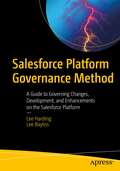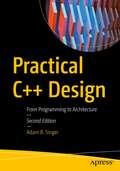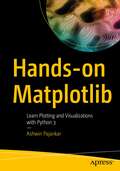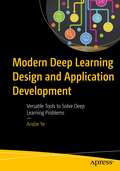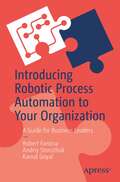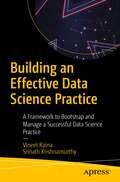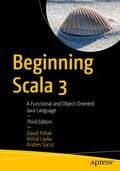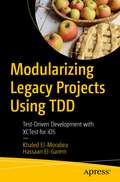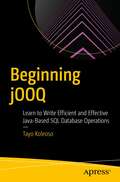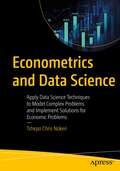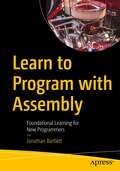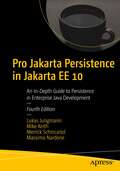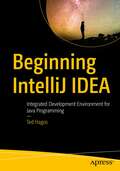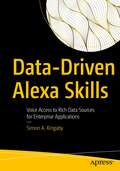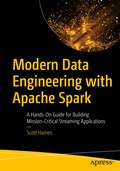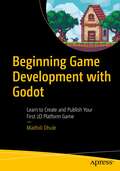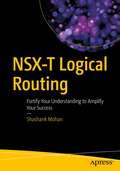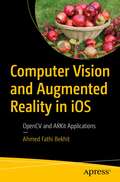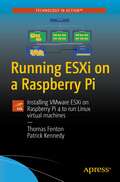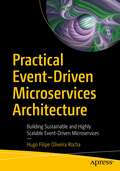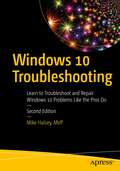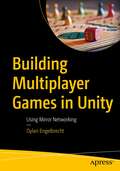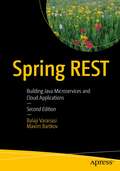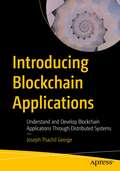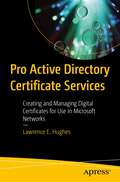- Table View
- List View
Salesforce Platform Governance Method: A Guide to Governing Changes, Development, and Enhancements on the Salesforce Platform
by Lee Harding Lee BaylissAccelerate your Salesforce implementation to provide benefits to your business more rapidly while maintaining control and improving quality.Salesforce has become one of the most influential business tools in our modern age. What started as the world's most comprehensive customer relationship management (CRM) system available in the market place has now morphed over the years into an ecosystem of tools and services that enable you to run your entire business platform. This book gives you a method (a set of governance processes) that provides a complete view of how to govern and manage any Salesforce implementation. It breaks the architectural components of the Salesforce platform into manageable sections, allowing you to navigate and understand how to govern your Salesforce implementation in a consistent manner with an approach that is structured, repeatable, and clearly defined. Salesforce Platform Governance Method is divided into nine distinct phases which have been chosen based on how the Salesforce platform is architected. This is relevant today because every organization that implements Salesforce will face the same issues around governance, integration, development, and security and the majority of organizations will find, through trial and error, a solution to govern these components. This book will help Salesforce professionals and enterprise organizations as well as small and mid-sized businesses (SMBs) navigate these topics and ultimately have a successful and fully integrated, secure Salesforce implementation. What You Will Learn Govern the application architecture on the Salesforce platform, including general architecture, localization and global deployments, workflow and process, formulas and files, and socialGovern the data architecture, including design and data optimization, performance, predictive and actual data volumes, and data movementGovern the identity and access management aspects of the application and Salesforce platformGovern the low-level platform capabilities delivered through Lightning, Visualforce, and ApexHandle community implementations that bring specific features into the Salesforce platform for consideration and governanceCreate checklists for the governance steps, laid out in the method, and for any tooling recommendations that can help simplify the process of governance Who This Book Is ForPeople responsible for maintaining a Salesforce SaaS instance or developing changes for that Salesforce instance. Readers should have a basic understanding of the Salesforce platform and a desire to introduce a level of control around the changes being made, reduce issues on their Salesforce instance, and improve quality while increasing the throughput of changes they want to introduce into the platform.
Practical C++ Design: From Programming to Architecture
by Adam B. SingerGo from competent C++ developer to skilled designer or architect using this book as your personal C++ design master class. Updated for the C++20 standard, this title will guide you through the design and implementation of an engaging case study that forms the backdrop for learning the art of applying design patterns and modern C++ techniques to create a high quality, robust application. Starting with a quick exploration of the requirements for building the application, you'll delve into selecting an appropriate architecture, eventually designing and implementing all of the necessary modules to meet the project’s requirements. By the conclusion of Practical C++ Design, you'll have constructed a fully functioning calculator capable of building and executing on any platform that supports both Qt and C++20. Access to the complete source code will help speed your learning. Utilize the Model-View-Controller pattern as the basis for the architecture of the calculator; the observer pattern to design an event system; the singleton pattern as you design the calculator’s central data repository, a reusable stack; the command pattern to design a command system supporting unlimited undo/redo; the abstract factory pattern to build a cross-platform plugin infrastructure for extensibility; coroutines to implement a command line interface with a lazy tokenizer; and more. After reading and using this book, you’ll have begun the transition from C++ programmer to architect. What You Will Learn Read a specification document and translate it into a practical C++ design using some of the latest language features from C++20Understand trade-offs in selecting between alternative design scenariosGain practical experience in applying design patterns to realistic development scenariosLearn how to effectively use language elements of modern C++ to create a lasting designDevelop a complete C++ program from a blank canvas through to a fully functioning, cross platform applicationRead, modify, and extend existing, high quality codeLearn the fundamentals of API design, including class, module, and plugin interfaces Who This Book Is For The experienced C++ developer ready to take the next step to becoming a skilled C++ designer.
Hands-on Matplotlib: Learn Plotting and Visualizations with Python 3
by Ashwin PajankarLearn the core aspects of NumPy, Matplotlib, and Pandas, and use them to write programs with Python 3. This book focuses heavily on various data visualization techniques and will help you acquire expert-level knowledge of working with Matplotlib, a MATLAB-style plotting library for Python programming language that provides an object-oriented API for embedding plots into applications. You'll begin with an introduction to Python 3 and the scientific Python ecosystem. Next, you'll explore NumPy and ndarray data structures, creation routines, and data visualization. You'll examine useful concepts related to style sheets, legends, and layouts, followed by line, bar, and scatter plots. Chapters then cover recipes of histograms, contours, streamplots, and heatmaps, and how to visualize images and audio with pie and polar charts. Moving forward, you'll learn how to visualize with pcolor, pcolormesh, and colorbar, and how to visualize in 3D in Matplotlib, create simple animations, and embed Matplotlib with different frameworks. The concluding chapters cover how to visualize data with Pandas and Matplotlib, Seaborn, and how to work with the real-life data and visualize it. After reading Hands-on Matplotlib you'll be proficient with Matplotlib and able to comfortably work with ndarrays in NumPy and data frames in Pandas. What You'll LearnUnderstand Data Visualization and Python using MatplotlibReview the fundamental data structures in NumPy and Pandas Work with 3D plotting, visualizations, and animationsVisualize images and audio dataWho This Book Is ForData scientists, machine learning engineers and software professionals with basic programming skills.
Modern Deep Learning Design and Application Development: Versatile Tools to Solve Deep Learning Problems
by Andre YeLearn how to harness modern deep-learning methods in many contexts. Packed with intuitive theory, practical implementation methods, and deep-learning case studies, this book reveals how to acquire the tools you need to design and implement like a deep-learning architect. It covers tools deep learning engineers can use in a wide range of fields, from biology to computer vision to business. With nine in-depth case studies, this book will ground you in creative, real-world deep learning thinking. You’ll begin with a structured guide to using Keras, with helpful tips and best practices for making the most of the framework. Next, you’ll learn how to train models effectively with transfer learning and self-supervised pre-training. You will then learn how to use a variety of model compressions for practical usage. Lastly, you will learn how to design successful neural network architectures and creatively reframe difficult problems into solvable ones. You’ll learn not only to understand and apply methods successfully but to think critically about it. Modern Deep Learning Design and Methods is ideal for readers looking to utilize modern, flexible, and creative deep-learning design and methods. Get ready to design and implement innovative deep-learning solutions to today’s difficult problems. What You’ll Learn Improve the performance of deep learning models by using pre-trained models, extracting rich features, and automating optimization.Compress deep learning models while maintaining performance. Reframe a wide variety of difficult problems and design effective deep learning solutions to solve them. Use the Keras framework, with some help from libraries like HyperOpt, TensorFlow, and PyTorch, to implement a wide variety of deep learning approaches. Who This Book Is For Data scientists with some familiarity with deep learning to deep learning engineers seeking structured inspiration and direction on their next project. Developers interested in harnessing modern deep learning methods to solve a variety of difficult problems.
Introducing Robotic Process Automation to Your Organization: A Guide for Business Leaders
by Robert Fantina Andriy Storozhuk Kamal GoyalFor your robotic process automation (RPA) program to be successful, you need to follow a general framework and governance model. This book covers, in detail, what they should look like and how to adapt them to your organization.Introducing Robotic Process Automation to Your Organization is structured to enable you, a novice to RPA, to successfully implement an RPA program at your company. RPA is rapidly growing in use, but is only starting to be taught at a university level. Many mid-level managers will be tasked with introducing an RPA program at their organizations as senior management learns of its efficacy, but will be unfamiliar with how to do so. This book provides you with the skills and information you need to make an informed decision. For decades, there has been much discussion about the fast pace of technology, the rapidly changing technology environment, and the need for companies to be on the cutting edge to remain competitive or even relevant. In this ever-changing environment, there is a need to know what can be done in terms of current processes, here and now, that will increase efficiency, benefit customers, and improve profitability. One option is RPA.This book includes information to assist you in getting the required buy-in and identifying the first few processes for automation. A structure for identifying opportunities on an ongoing basis is detailed, along with concepts that must be considered for solution design and deployment. Throughout the book there are several "pause and consider" statements to help you think about how principles pertain to your organization. Additionally, there are tips included that offer short, concrete suggestions on how to help implement the particular step being discussed.What You Will LearnKnow the benefits of robotic process automation (RPA)Understand the limitations of RPAAsk the right questions to determine whether a process is a good candidate for automationObtain buy-in from skeptics at the senior and middle manager levels, and from line workersBe familiar with the structure required for successWho This Book is ForMiddle managers who have either identified the need for robotic process automation (RPA) in their organization or have been directed by senior management to explore the possibility of introducing RPA to their organization; managers at all levels who hear about RPA, either through conferences, professional associations, or industry publications, and want to know more; students of business and technology who wish to broaden their understanding of important current trends.
Building an Effective Data Science Practice: A Framework to Bootstrap and Manage a Successful Data Science Practice
by Vineet Raina Srinath KrishnamurthyGain a deep understanding of data science and the thought process needed to solve problems in that field using the required techniques, technologies and skills that go into forming an interdisciplinary team. This book will enable you to set up an effective team of engineers, data scientists, analysts, and other stakeholders that can collaborate effectively on crucial aspects such as problem formulation, execution of experiments, and model performance evaluation.You’ll start by delving into the fundamentals of data science – classes of data science problems, data science techniques and their applications – and gradually build up to building a professional reference operating model for a data science function in an organization. This operating model covers the roles and skills required in a team, the techniques and technologies they use, and the best practices typically followed in executing data science projects.Building an Effective Data Science Practice provides a common base of reference knowledge and solutions, and addresses the kinds of challenges that arise to ensure your data science team is both productive and aligned with the business goals from the very start. Reinforced with real examples, this book allows you to confidently determine the strategic answers to effectively align your business goals with the operations of the data science practice. What You’ll Learn Transform business objectives into concrete problems that can be solved using data scienceEvaluate how problems and the specifics of a business drive the techniques and model evaluation guidelines used in a projectBuild and operate an effective interdisciplinary data science team within an organizationEvaluating the progress of the team towards the business RoIUnderstand the important regulatory aspects that are applicable to a data science practice Who This Book Is For Technology leaders, data scientists, and project managers
Beginning Scala 3: A Functional and Object-Oriented Java Language
by Vishal Layka David Pollak Andres SaccoLearn the latest version of Scala through simple, practical examples. This book introduces you to the Scala programming language, its object-oriented and functional programming characteristics, and then guides you through Scala constructs and libraries that allow you to assemble small components into high-performance, scalable systems. Beginning Scala 3 explores new Scala 3 language features such as Top-level declarations, Creator applications, Extension methods to add extra functionality to existing types, and Enums. You will also learn new ways to manipulate types via Union types, intersection, literal, and opaque type aliases. Additionally, you’ll see how Implicits are replaced by given and using clauses. After reading this book, you will understand why Scala is judiciously used for critical business applications by leading companies such as Twitter, LinkedIn, Foursquare, the Guardian, Morgan Stanley, Credit Suisse, UBS, and HSBC – and you will be able to use it in your own projects. What You Will LearnGet started with Scala 3 or Scala language programming in generalUnderstand how to utilitze OOP in Scala Perform functional programming in ScalaMaster the use of Scala collections, traits and implicitsLeverage Java and Scala interopabilityEmploy Scala for DSL programmingUse patterns and best practices in ScalaWho This Book Is For Those with a background in Java and/or Kotlin who are new to Scala. This book is also for those with some prior Scala experience who want to learn Scala version 3.
Modularizing Legacy Projects Using TDD: Test-Driven Development with XCTest for iOS
by Khaled El-Morabea Hassaan El-GaremImprove current or new projects with top notch testability and maintainability. Writing tests improves the design of your apps, as it pushes you to have a more modularized design. This in turn improves the maintainability and sustainability of your apps. This book is for iOS developers who already know the basics of iOS and Swift development but want to learn all the testing pro features in iOS.You'll start by reviewing the TDD Cycle and how to implement these concepts on a legacy project or a new one. You'll then walk through TDD step-by-step on a blank project, including setting up test targets, assertions, and expectations. You'll follow that with all levels of testing such as unit tests, integration tests, and end-to-end tests, and also tackle fairly complex, yet badly written legacy code. The book will take you through the journey of modularizing a legacy app using TDD. Throughout this journey, you will be introduced to multiple testing concepts and techniques, like writing tests for network and core data layers. You will write tests to ensure the thread safety of your app. And you’ll add a new feature while you are in the middle of refactoring, which is an important skill so you can keep adding features while you are fixing your technical debt. By the end of this book, you will have all the tools needed to become a testing master. What You'll LearnUse mocking and dependency injection to make components more testable Write tests for asynchronous code like network code Add new features to existing legacy apps using TDDWho This Book Is ForExperienced iOS developers who care about software quality and meeting customer expectations.
Beginning jOOQ: Learn to Write Efficient and Effective Java-Based SQL Database Operations
by Tayo KoleosoLearn to use the jOOQ library to manage SQL database operations in Java and JVM applications. This book walks you through what JOOQ is, how to install and get started with it, and then gets you working with it. Practical examples and case studies demonstrate how jOOQ offers a more efficient and versatile alternative to Object-Relational Mapping frameworks like Hibernate and JPA, while providing a natural, native-SQL feeling for the developer. You'll see how to maximize the full potential of your SQL database with advanced query syntax and functions with this lightweight, SQL-friendly framework. Come see how you can use high performance approaches like reactive, data streaming and cloud-native programming to get data from SQL tables. Never write another incorrect SQL statement again and protect your application from SQL injection with the strong typing and inbuilt controls in jOOQ. Learn how to add jOOQ to your existing Hibernate, Spring Boot or Quarkus applications. When you’ve completed this book, you will be able to take the knowledge you’ve gained, along with the freely available source code, and directly apply them to your own work. What You Will Learn Comparing equivalent features between Hibernate, JPA and jOOQUnlock the power of your SQL database with high performing, flexible and typesafe SQL queriesSeamlessly work with many different SQL database vendors without changing your codeEffortlessly generate Java code based on the content of your databaseWrite reactive SQL database access code with R2DBCIntegrating jOOQ into popular frameworks and platforms like Hibernate, Spring boot and Quarkus tools like IDEsTesting jOOQ-based code with modern integration testing frameworks like TestContainers and DockerLearn how to safely handle data access code within frameworks like the Java Persistence API (JPA) Who This Book Is For Intermediate Java programmers new to jOOQ. Some prior experience with SQL may be helpful but not required.
Econometrics and Data Science: Apply Data Science Techniques to Model Complex Problems and Implement Solutions for Economic Problems
by Tshepo Chris NokeriGet up to speed on the application of machine learning approaches in macroeconomic research. This book brings together economics and data science.Author Tshepo Chris Nokeri begins by introducing you to covariance analysis, correlation analysis, cross-validation, hyperparameter optimization, regression analysis, and residual analysis. In addition, he presents an approach to contend with multi-collinearity. He then debunks a time series model recognized as the additive model. He reveals a technique for binarizing an economic feature to perform classification analysis using logistic regression. He brings in the Hidden Markov Model, used to discover hidden patterns and growth in the world economy. The author demonstrates unsupervised machine learning techniques such as principal component analysis and cluster analysis. Key deep learning concepts and ways of structuring artificial neural networks are explored along with training them and assessing their performance. The Monte Carlo simulation technique is applied to stimulate the purchasing power of money in an economy. Lastly, the Structural Equation Model (SEM) is considered to integrate correlation analysis, factor analysis, multivariate analysis, causal analysis, and path analysis.After reading this book, you should be able to recognize the connection between econometrics and data science. You will know how to apply a machine learning approach to modeling complex economic problems and others beyond this book. You will know how to circumvent and enhance model performance, together with the practical implications of a machine learning approach in econometrics, and you will be able to deal with pressing economic problems. What You Will LearnExamine complex, multivariate, linear-causal structures through the path and structural analysis technique, including non-linearity and hidden statesBe familiar with practical applications of machine learning and deep learning in econometricsUnderstand theoretical framework and hypothesis development, and techniques for selecting appropriate modelsDevelop, test, validate, and improve key supervised (i.e., regression and classification) and unsupervised (i.e., dimension reduction and cluster analysis) machine learning models, alongside neural networks, Markov, and SEM modelsRepresent and interpret data and models Who This Book Is ForBeginning and intermediate data scientists, economists, machine learning engineers, statisticians, and business executives
Learn to Program with Assembly: Foundational Learning for New Programmers
by Jonathan BartlettMany programmers have limited effectiveness because they don't have a deep understanding of how their computer actually works under the hood. In Learn to Program with Assembly, you will learn to program in assembly language - the language of the computer itself. Assembly language is often thought of as a difficult and arcane subject. However, author Jonathan Bartlett presents the material in a way that works just as well for first-time programmers as for long-time professionals. Whether this is your first programming book ever or you are a professional wanting to deepen your understanding of the computer you are working with, this book is for you. The book teaches 64-bit x86 assembly language running on the Linux operating system. However, even if you are not running Linux, a provided Docker image will allow you to use a Mac or Windows computer as well.The book starts with extremely simple programs to help you get your grounding, going steadily deeper with each chapter. At the end of the first section, you will be familiar with most of the basic instructions available on the processor that you will need for any task. The second part deals with interactions with the operating system. It shows how to make calls to the standard library, how to make direct system calls to the kernel, how to write your own library code, and how to work with memory. The third part shows how modern programming language features such as exception handling, object-oriented programming, and garbage collection work at the assembly language level. Additionally, the book comes with several appendices covering various topics such as running the debugger, vector processing, optimization principles, a list of common instructions, and other important subjects.This book is the 64-bit successor to Jonathan Bartlett's previous book, Programming from the Ground Up, which has been a programming classic for more than 15 years. This book covers similar ground but with modern 64-bit processors, and also includes a lot more information about how high level programming language features are implemented in assembly language.What You Will LearnHow the processor operates How computers represent data internally How programs interact with the operating systemHow to write and use dynamic code librariesHow high-level programming languages implement their features Who This Book Is ForAnyone who wants to know how their computer really works under the hood, including first time programmers, students, and professionals.
Pro Jakarta Persistence in Jakarta EE 10: An In-Depth Guide to Persistence in Enterprise Java Development
by Mike Keith Merrick Schincariol Massimo Nardone Lukas JungmannLearn to use the Jakarta Persistence API and other related APIs as found in the Jakarta EE 10 platform from the perspective of one of the specification creators. A one-of-a-kind resource, this in-depth book provides both theoretical and practical coverage of Jakarta Persistence usage for experienced Java developers.Authors Lukas Jungmann, Mike Keith, Merrick Schincariol, Massimo Nardone take a hands-on approach, based on their wealth of experience and expertise, by giving examples to illustrate each concept of the API and showing how it is used in practice. The examples use a common model from an overarching sample application, giving you a context from which to start and helping you to understand the examples within an already familiar domain. After completing this in-depth book, you will have a full understanding of persistence and be able to successfully code applications using its annotations and APIs. The book also serves as an excellent reference guide.What You Will LearnUse Jakarta Persistence in the context of enterprise applicationsWork with object relational mappings (ORMs), collection mappings and moreBuild complex enterprise Java applications that persist data long after the process terminatesConnect to and persist data with a variety of databases, file formats, and moreUse queries, including the Jakarta Persistence Query Language (Jakarta Persistence QL)Carry out advanced ORM, queries and XML mappingsPackage, deploy and test your Jakarta persistence-enabled enterprise applicationsWho This Book Is ForExperienced Java programmers and developers with at least some prior experience with Jakarta EE or Java EE platform APIs.
Beginning IntelliJ IDEA: Integrated Development Environment for Java Programming
by Ted HagosGet started quickly with IntelliJ, from installation to configuration to working with the source code and more. This tutorial will show you how to leverage IntelliJ’s tools to develop clean, efficient Java applications. Author Ted Hagos will first walk you through buidling your first Java applications using IntelliJ. Then, he’ll show you how to analyze your application, top to bottom; using version control and tools that allow you expand your application for big data or data science applications and more. You'll also learn some of the IDE’s advanced features to fully maximize your application's capabilities. The last portion of the book focuses on application testing and deployment, and language- and framework- specific guidelines. After reading this book and working through its freely available source code, you'll be up to speed with this powerful IDE for today's Java development. What You Will Learn Use IntelliJ IDEA to build Java applications Set up your IDE and project Work with source code Extend your Java application to data science and other kinds of applications Test and deploy your application and much more Who This Book Is For Programmers new to IntelliJ IDEA who may have some prior exposure to Java programming.
Data-Driven Alexa Skills: Voice Access to Rich Data Sources for Enterprise Applications
by Simon A. KingabyDesign and build innovative, custom, data-driven Alexa skills for home or business. Working through several projects, this book teaches you how to build Alexa skills and integrate them with online APIs. If you have basic Python skills, this book will show you how to build data-driven Alexa skills. You will learn to use data to give your Alexa skills dynamic intelligence, in-depth knowledge, and the ability to remember. Data-Driven Alexa Skills takes a step-by-step approach to skill development. You will begin by configuring simple skills in the Alexa Skill Builder Console. Then you will develop advanced custom skills that use several Alexa Skill Development Kit features to integrate with lambda functions, Amazon Web Services (AWS), and Internet data feeds. These advanced skills enable you to link user accounts, query and store data using a NoSQL database, and access real estate listings and stock prices via web APIs.What You Will LearnSet up and configure your development environment properly the first timeBuild Alexa skills quickly and efficiently using Agile tools and techniquesCreate a variety of data-driven Alexa skills for home and businessAccess data from web applications and Internet data sources via their APIsTest with unit-testing frameworks throughout the development life cycleManage and query your data using the DynamoDb NoSQL database enginesWho This Book Is ForDevelopers who wish to go beyond Hello World and build complex, data-driven applications on Amazon's Alexa platform; developers who want to learn how to use Lambda functions, the Alexa Skills SDK, Alexa Presentation Language, and Alexa Conversations; developers interested in integrating with public APIs such as real estate listings and stock market prices. Readers will need to have basic Python skills.
Modern Data Engineering with Apache Spark: A Hands-On Guide for Building Mission-Critical Streaming Applications
by Scott HainesLeverage Apache Spark within a modern data engineering ecosystem. This hands-on guide will teach you how to write fully functional applications, follow industry best practices, and learn the rationale behind these decisions. With Apache Spark as the foundation, you will follow a step-by-step journey beginning with the basics of data ingestion, processing, and transformation, and ending up with an entire local data platform running Apache Spark, Apache Zeppelin, Apache Kafka, Redis, MySQL, Minio (S3), and Apache Airflow.Apache Spark applications solve a wide range of data problems from traditional data loading and processing to rich SQL-based analysis as well as complex machine learning workloads and even near real-time processing of streaming data. Spark fits well as a central foundation for any data engineering workload. This book will teach you to write interactive Spark applications using Apache Zeppelin notebooks, write and compile reusable applications and modules, and fully test both batch and streaming. You will also learn to containerize your applications using Docker and run and deploy your Spark applications using a variety of tools such as Apache Airflow, Docker and Kubernetes.Reading this book will empower you to take advantage of Apache Spark to optimize your data pipelines and teach you to craft modular and testable Spark applications. You will create and deploy mission-critical streaming spark applications in a low-stress environment that paves the way for your own path to production. What You Will LearnSimplify data transformation with Spark Pipelines and Spark SQLBridge data engineering with machine learningArchitect modular data pipeline applications Build reusable application components and libraries Containerize your Spark applications for consistency and reliabilityUse Docker and Kubernetes to deploy your Spark applicationsSpeed up application experimentation using Apache Zeppelin and Docker Understand serializable structured data and data contracts Harness effective strategies for optimizing data in your data lakes Build end-to-end Spark structured streaming applications using Redis and Apache Kafka Embrace testing for your batch and streaming applications Deploy and monitor your Spark applications Who This Book Is ForProfessional software engineers who want to take their current skills and apply them to new and exciting opportunities within the data ecosystem, practicing data engineers who are looking for a guiding light while traversing the many challenges of moving from batch to streaming modes, data architects who wish to provide clear and concise direction for how best to harness and use Apache Spark within their organization, and those interested in the ins and outs of becoming a modern data engineer in today's fast-paced and data-hungry world
Beginning Game Development with Godot: Learn to Create and Publish Your First 2D Platform Game
by Maithili DhuleLearn the fundamentals of Godot by diving headfirst into creating a 2D platformer from scratch. This book is a hands-on, practical guide to developing 2D games using the Godot Engine 3.2.3/3.3, with the help of GDScript. Author Maithili Dhule begins by explaining some basic tools and techniques used to make games, the factors that need to be considered while choosing a game engine, and pointing out the benefits of using Godot. She then walks you through downloading the engine and guides you as you explore key features of its interface. Next, you’ll receive a concise introduction to the basics of GDScript, the main scripting language used in Godot, before moving on to essential topics such as Godot’s node-scene architecture, the interaction of various physics bodies, the creation of game scenes, and writing scripts. As the book progresses, you’ll learn how to create and animate your game character, design the game world, add enemies, and implement a coin-collection system. You’ll also see how the user’s gaming experience can be enhanced through the addition of parallax backgrounds, a title screen, music, and sound effects. Toward the end of the book, you’ll learn how to export your game to different platforms, both mobile and PC, as well as possible avenues for monetizing the game. Throughout the book, theoretical concepts are supplemented with concrete, ready-to-implement examples that you can try out. Upon finishing this book, you’ll be able to make and publish your first 2D platform game. Beginning Game Development with Godot is for game development enthusiasts of all levels interested in creating their own games.What You Will LearnUnderstand the Godot engine and the benefits of using it for game developmentMaster the fundamentals of programming in GDScriptUse the Godot graphical interface to design and animate players, the game world, menus, and various games scenes Create your first 2D game in Godot and publish it to various platforms Who This Book Is ForAspiring game developers who may be new to game development, as well as experts exploring the potential of the Godot Engine.
NSX-T Logical Routing: Fortify Your Understanding to Amplify Your Success
by Shashank MohanThis book is a one-stop guide for IT professionals with a background in traditional and software-defined networks looking to expand or hone their skill set and has been developed through a combination of extensive research and testing in both development and production environments. It provides reliable information on a fundamental component of NSX-T, logical routing.A comprehensive understanding of this capability will help IT professionals with design, implementation, troubleshooting, and enhancements.The book starts with an introduction to the foundational components of the NSX-T platform and how NSX-T fits into the software-defined data center. The focus then moves to tunnel endpoints, which is a critical aspect of the NSX-T platform, and the differences between overlays and underlays are explained. Once the basics are covered, it provides a detailed description of how NSX-T components communicate.Next, the book introduces logical routing and its components and provides a better understanding of how these components function with one another. Several packet walks are illustrated to explain NSX-T logical routing behavior in different scenarios. After mastering logical routing, it explains how NSX-T ensures data plane availability, which is explored at various layers of NSX-T.Finally, the book explores the concepts and intricacies of routing into and out of the NSX-T environment. It deep dives into utilizing the Border Gateway Protocol (BGP), Open Shortest Path First (OSPF), and Static Routing.What You Will LearnKnow how VMware NSX-T endpoints communicate Understand how NSX-T logical routing works Know how NSX-T provides high availability for the data plane Understand how NSX-T operates with static and dynamic routing protocolsConfigure the platform Who This Book Is ForReaders with an intermediate to advanced skill set who wish to further their knowledge, those who focus on datacenter technology, those planning to move to a software-defined datacenter to transform the way their current datacenter works, and anyone looking to learn about VMware NSX-T and how it operates
Computer Vision and Augmented Reality in iOS: OpenCV and ARKit Applications
by Ahmed Fathi BekhitLearn how computer vision works, how augmented reality renders digital graphics into the physical world via an iPhone’s camera, and how to incorporate these technologies into your own apps. This book shows you how to take full advantage of computer vision technologies.Interacting with other people online usually involves user-generated images and videos; whether it be “memes”, short videos, or heavily-modified images. Before smart phones, generating this content required a professional using high-level image and video editing software. Not any more. This book will teach you to use computer vision in the most popular ways, such as for facial recognition, image to text analysis and, of course, recording a video of a dancing hot dog in your living room. Starting with the history of computer vision, image and video processing fundamentals, and an introduction to developing augmented reality applications, you’ll learn to incorporate computer vision both in the content you create and the apps you develop for end users. Computer Vision and Augmented Reality in iOS reveals how every user with access to the Internet and a smart phone can easily generate heavily-modified images and videos. What You'll LearnIncorporate mathematics related to computer vision into your appsHost computer vision models remotely for mobile useImplement visual-inertial state estimation algorithms for mobile augmented realityWho This Book Is ForProfessionals or post graduate students in software development or engineering who have a basic understanding of how software development works and are interested in implementing computer vision into their development. It's recommended that readers already have a working knowledge of C++ and Swift.
Running ESXi on a Raspberry Pi: Installing VMware ESXi on Raspberry Pi 4 to run Linux virtual machines
by Thomas Fenton Patrick KennedyGain foundational knowledge of ESXi technology and understand why it is such a dominant force in the datacenter. This book also looks beyond ESXi to other vSphere technologies, such as virtual machines (VMs), vMotion, and vCenter Server. Knowing how these technologies complement ESXi running on a Raspberry Pi will help you get the most out of ESXi on Arm technologies. This marks a significant change for ESXi, and has created new learning opportunities and use cases for both seasoned ESXi users and users completely new to the virtualization space. For those already familiar with ESXi but new to the Raspberry Pi, you’ll develop an in-depth understanding of this device and why it has become such a popular platform for technologists. Once you’ve learned the fundamentals, you’ll be introduced to enterprise, edge, and personal use-cases for this technology. Then, you’ll be walked through the process of installing ESXi on a Pi, as well as managing and monitoring it. You will also come to recognize its strengths and limitations and become familiar with the storage and networking options that are currently available. Lastly, given the fact that the sole purpose of running ESXi on a Pi is to run VMs on it, you’ll receive detailed step-by-step instructions for installing popular OSes including Ubuntu, CentOS, and Raspberry Pi OS. What You'll LearnBuild a fully functional ESXi server on a Raspberry PiSelect the correct hardware for particular use casesCreate and optimize virtual machines running on a PiRun Kubernetes on a Pi running ESXi Who This Book Is ForThose new to the datacenter who want a low-cost way to work with one of the most powerful datacenter technologies to experienced datacenter professionals who need to use ESXi on Arm to complement their enterprise’s long-term strategic goals.
Practical Event-Driven Microservices Architecture: Building Sustainable and Highly Scalable Event-Driven Microservices
by Hugo Filipe Oliveira RochaIn the simplest terms, event-driven architectures are like onions; they are manageable as a single layer (like a monolith) but when you get into them, they begin to cascade apart and you quickly realize that there are many complex layers (distributed microservices architecture). And that’s when the tears begin.This prescriptive guide takes you through the steps of moving a platform with millions of users from a monolith to a microservices event-driven architecture. You will learn about the challenges and complexities that arise in high-throughput environments that often contain upwards of hundreds of microservices. This book is designed to be your single best resource for learning how to apply event-driven architectures in real-world scenarios and offers hundreds of patterns to overcome the common and not so common challenges.While event-driven architectures have been the standard for decoupled, pluggable, evolutionary architectures for years, they have only recently been adopted by enterprises for the purpose of distributed microservices and there is little information about adopting them. Using them at scale can save valuable resources, but requires different considerations, including the added complexity of supporting several moving parts and getting the event schema right from the start in order to avoid large restructuring later on.Author Hugo Rocha understands that these kinds of challenges, as well as many others, need to be considered from the beginning, and helps teach you the mindset needed to create a deliberate strategy upfront. This book offers learning approaches and patterns to get you up to speed in order to sustainably build and manage event-driven architectures.What You Will LearnUnderstand the real-world challenges of event-driven architectures and the patterns to deal with those challenges and the trade-offs of each solutionLeverage the advantages of event-driven architectures to build scalable solutions and address legacy applicationsPlan successful future implementations to avoid common pitfalls and apply proven patterns to deal with challenges in a real-world platform with millions of usersDecide whether event-driven solutions are the right choice for the requirements at handDiscuss and understand advanced concepts about event-driven architectures Who Is This Book ForSoftware engineers and software architects. Anyone currently working with microservice architectures, primarily event-driven microservices, will greatly benefit from this book. Readers working with monoliths will benefit, as the book explores migration from a monolithic application to an event-driven microservice architecture.
Windows 10 Troubleshooting: Learn to Troubleshoot and Repair Windows 10 Problems Like the Pros Do
by Mike HalseyTroubleshoot Windows 10 the way the experts do, whatever device or form factor you are using. Focus on the problems that most commonly plague PC users and fix each one with a step-by-step approach that helps you understand the cause, solution, and tools required.Windows 10 is constantly evolving and changing and a great many aspects of the operating system, including many associated with troubleshooting and repair, have been changed, removed, replaced, or expanded since the first edition of this book was published. This new edition is updated with a dedicated chapter on using scripting tools for troubleshooting along with numerous updates on Windows device and update installation, Microsoft Sysinternals Suite, and Troubleshooting malware attacks. Additionally, there is extensive coverage of the technical diagnosis and troubleshooting tools you need from Event Viewer to Recovery Console. This book will help you discover the connections between different hardware and software in your devices, and how their bonds with external hardware, networks, and the Internet are more inter-dependent than you think. You will also learn how to support the increasing volume of home workers, and make sure they can stay online and active on PCs from your own organization or their own devices.If you are fed up with those nagging, day-to-day issues, want to avoid costly repairs, or just want to learn more about how PCs work, Windows 10 Troubleshooting is your ideal one-stop guide to the Windows 10 operating system.What You Will LearnUnderstand your PC’s ecosystem and how to connect the dots, so you can successfully track problems to their sourceSupport home workers using PCs from your organization and family devices, and keep workers productive and onlineMake your PC safe and secure for family and everyone in your workplace, and ensure that data is kept secure from loss or attackUnderstand the threat from malware and viruses and a range of approaches to dealing with them, depending on the situationKnow tips and tricks for researching difficult problems, including third-party tools and useful web resourcesWho This Book Is ForAnyone using Windows 10 on a desktop, laptop, or hybrid device
Building Multiplayer Games in Unity: Using Mirror Networking
by Dylan EngelbrechtTake a deep dive into creating large-scale, multiplayer games with Unity 3D, using Mirror Networking and a variety of powerful transports. You will learn the fundamentals of RPC/Command multiplayer architecture and dig deeper into networking and data persistence to achieve scalable, highly performant, large-scale, multiplayer games in Unity.This book explains how to develop multiplayer games using Unity within a commercial or enterprise environment. You will take a look at the networking fundamentals behind multiplayer games, including packets and the importance of keeping packets small. Next, you will look into Mirror Networking and see how to leverage a variety of transport layers to achieve large-scale, multiplayer games. Using Unity 3D as the core focus, you will get an understanding of the RPC/Command architecture and how you can utilize different authoritative structures to best suit your needs. You will also learn how to scale your architecture and explore industry-leading methods of deploying your game to the masses. You will also get a solid understanding of networking principles. The book wraps up with advice from leading experts who shed light on past mistakes and provide valuable insights for your next project. This book breaks down daunting concepts into easy-to-understand pieces of knowledge to help you create your first multiplayer game. It is a must-read for any developer looking to understand multiplayer games and networking.What You Will Learn● Learn advanced multiplayer concepts and how to use them● Understand the key concepts for creating multiplayer virtual experiences● Know the basics of computer networking and how to employ them● Deploy large, scalable multiplayer infrastructures for your games● Gain insights from other industry professionalsWho Is This Book ForIntermediate to advanced Unity 3D developers looking to understand multiplayer networking and deploying large-scale products. Having a solid understanding of C# and Unity is required, and having an understanding or prior experience with networking principles such as IPv4 would be advantageous.
Spring REST: Building Java Microservices and Cloud Applications
by Balaji Varanasi Maxim BartkovDesign and develop Java-based RESTful APIs using the latest versions of the Spring MVC and Spring Boot frameworks. This book walks you through the process of designing and building a REST application while delving into design principles and best practices for versioning, security, documentation, error handling, paging, and sorting. Spring REST provides a brief introduction to REST, HTTP, and web infrastructure. You will learn about several Spring projects such as Spring Boot, Spring MVC, Spring Data JPA, and Spring Security, and the role they play in simplifying REST application development. You will learn how to build clients that consume REST services. Finally, you will learn how to use the Spring MVC test framework to unit test and integration test your REST API. After reading this book, you will come away with all the skills to build sophisticated REST applications using Spring technologies. What You Will LearnBuild Java-based microservices, native cloud, or any applications using Spring RESTEmploy Spring MVC and RESTful SpringBuild a QuickPoll application exampleDocument REST services, as well as versioning, paging, and sortingTest, handle errors and secure your application Who This Book Is For Intermediate Java programmers with at least some prior experience with Spring and web/cloud application development.
Introducing Blockchain Applications: Understand and Develop Blockchain Applications Through Distributed Systems
by Joseph Thachil GeorgeDeepen your understanding of blockchain technology and develop your own blockchain applications. This book provides a thorough review of distribution-based systems on blockchain technology, starting from the fundamental concepts that underlie it, all the way through the implementation of a blockchain network for business purposes. Author Joseph Thachil George begins by introducing you to blockchain and some basic concepts of technology, including distributed systems, systems of systems, cyber-physical systems, the Byzantine Consensus, the CAP theorem, and cryptographic techniques. Next, he analyzes the structure of blocks and smart contracts and the mother of all blockchain platforms, Bitcoin. That sets the stage for an examination of transaction structure, validation, and flow, from creation to registration in the ledger and structure of the blocks, the Nakamoto consensus, and finally forks. From there, you’ll experience a deep dive into Ethereum; including the concepts of Gas and Message, smart contracts and the Ethereum virtual machine. From there, you’ll learn about the Ethereum consensus protocol, Ethereum Casper, and the Ethereum Proof-of-Stake algorithm. You’ll then see how blockchain can be connected to a distributed system, followed by a demonstration of how you can model a distributed system using Blockly4SoS and Kilobots. The concluding chapters offer a practical example that combines distributed systems with blockchain technology. After reading this book, you will understand how to implement blockchain technology in a distributed system and be able to leverage this knowledge in your own projects. What You Will Learn Learn the concept of blockchains by way of a practical example Grasp the connection between distributed systems and blockchain technologyLearn the design of blockchain with hyperledger fabricLearn the design of cyber-physical systems in a distributed environment Who Is This Book For Developers who are enthusiastic about the design and implementation of distributed systems.
Pro Active Directory Certificate Services: Creating and Managing Digital Certificates for Use in Microsoft Networks
by Lawrence E. HughesIn order to deploy and use Microsoft Certificate Services, you need to understand the fundamentals of cryptography, digital signatures, encryption, TLS, and S/MIME. It is also important to understand the concepts behind public key infrastructure (PKI). This book teaches you all the required background knowledge you need. Then it takes you deeper, step by step, teaching you how to deploy Certificate Services and configure it to issue various digital certificate types, complete with examples of using these certificates with IIS, Outlook, and Windows.Microsoft-based networks—on-premises, hybrid, and cloud-based networks—are used in companies of all sizes. Within them, there are many applications of digital certificates that can be created and managed by Microsoft Certificate Services. As security is more important than ever, and cryptography and PKI are fundamental to so many of these defenses, understanding Microsoft Certificate Services is becoming an increasingly more desirable skill. Most IT workers don’t realize the many uses and purposes of Certificate Services, especially within a corporate or government agency network, and how tightly integrated they are with the Microsoft Windows Domain style of networks and Active Directory (on-premises or cloud-based, including Azure, AWS, and Google Cloud Services). This book will teach you the gamut. You will appreciate the learning approach presented in the book, beginning with the basics (cryptographic primitives such as encryption and message digests), getting into combinations of primitives to accomplish specific things (such as digital signatures and envelopes), and then trying real-word systems based on digital certificates and PKI (such as TLS, S/MIME secure email, cryptographic authentication, and more). The book wraps it all up and teaches you how to deploy Certificate Services and issue the various types of certificates, including how they are used. What You Will Learn Understand basic cryptography (symmetric and asymmetric key encryption, message digests, and digital signatures and envelopes)Know how TLS, S/MIME, and cryptographic authentication workDiscover applications of cryptography related to secure servers with TLS and cryptographic (passwordless) authentication to online services including Windows and secure emailGet to know the common types of digital certificates, how to create and manage them, and examples of their use with IIS, Outlook, etc. Who This Book Is ForMicrosoft system and network engineers, security engineers, and CISOs. Readers should have familiarity with Windows Server 2019 (or more recent) and Active Directory.
